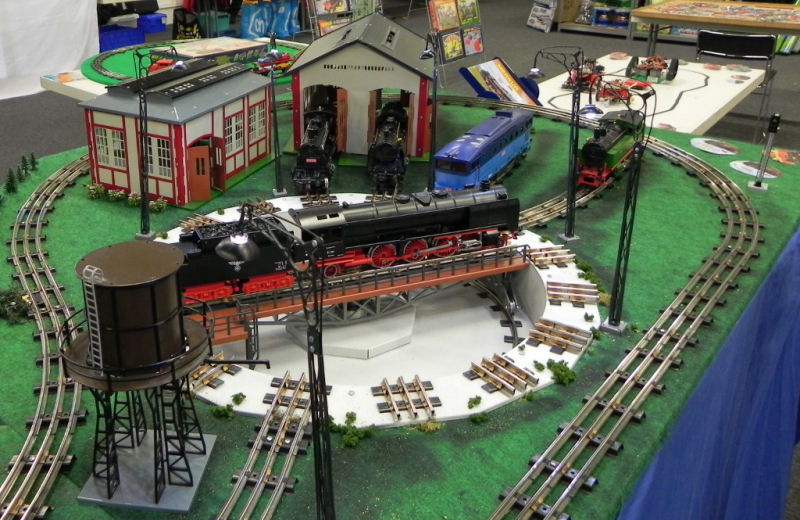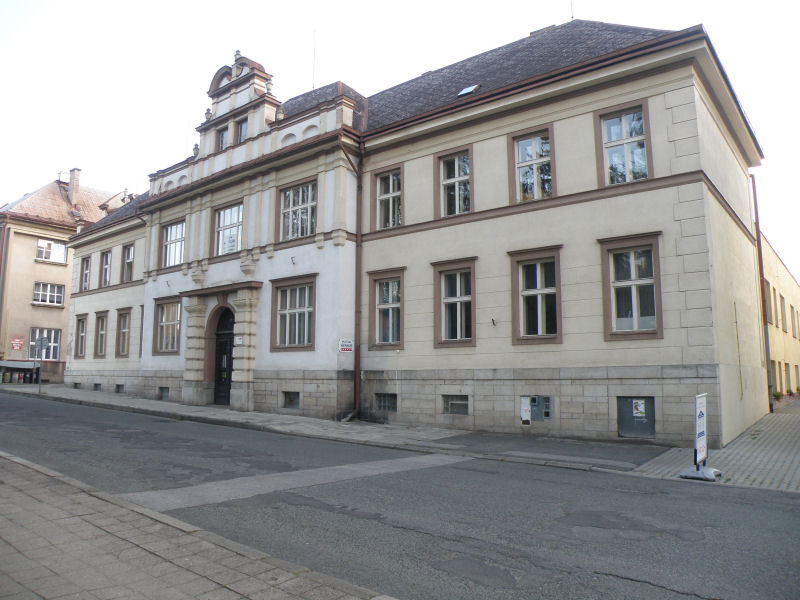







By Egbert van Velzen

Merkur Museum Layout
Introduction
Most tinplate toy train collectors know Merkur as a prewar brand from Czechoslovakia. Since their reintroduction in 2002, Merkur has produced modern coarse scale 0 gauge tinplate and markets it predominantly on the European market. Consequently, affordable, well-made modern tinplate train models are now widely available throughout Europe and this has reshaped the European market.
History
Merkur started the production of metal construction sets in 1920 in Police nad Metuji (Czech Republic). One of the sets contained the parts to build a model train. Customers then asked Merkur to produce a model train. And so in 1930 Merkur started to produce tinplate model trains in gauge 0.

Merkur Ad from 1935
Unlike most other model train manufacturers of the inter bellum, Merkur used screws and nuts to assemble their wagons and carriages. Consequently, Merkur train car models are known for their robustness. During the second world war, production was largely discontinued. In 1947 the production started again. The Czech government nationalized the factory in 1953 and terminated the production in 1968 for unclear reasons. In the course of the following years, the tools for the production of train models disappeared. Construction building sets were still marketed under the trade name Merkur. Meccano, the main competitor of Merkur, even challenged them before the International Court of Justice. Merkur had used the English word Meccano in one of their construction set manuals. Meccano and the court regarded that and as a violation of the trademark law.

One of the factory buildings in Police nad Metuji. Notice “Merkur” on the chimney.
In 1990, just after the velvet revolution, Jaromir Kriz became the owner of the Merkur factory. He decided to produce model trains again. He purchased machinery, tooling and design software, and the first modern Merkur electric model trains rolled out of the factory in 2003. These were modern tin-plate trains in 0 gauge, completely compatible with the pre-war Merkur trains.

Jaromir Kriz, Jr. working
Modern Merkur Tinplate
From 2003 on, Merkur produced a huge range of locomotives,
freight cars, passenger cars, tank cars, beer cars, buildings, tubular tracks
and accessories. They initially focused on models of the Czech railroad (CD),
but have expanded to produce German, French, Austrian, Hungarian and British
train models as well. Their tubular tracks are fully compatible with Märklin,
Lionel, Hornby, Bing and many others. Their standard straight rail sections
are 30 cm (12 inches) long. But they also produce 90 cm (36 inch) long straights.
Their curved rail sections all form 1/16 of a circle (or 22.5 degrees) and are
sold in three different radii; 62.5 cm, 76 cm and 90 cm. This is roughly comparable
to 050, 060 and 072, in terms of Lionel tubular tracks. Their track assortment
further encompasses switches (manual or electric), crossings, grade crossings,
etc. Merkur tubular tracks and switches are popular among European vintage toy
train enthusiasts, because the rails are well-made and affordable.

Merkur (left) and Lionel (right) tubular track.
Modern Merkur Tinplate Engines
The first modern engine that Merkur introduced in 2003 was a 2-6-2 (Prairie) steam engine with a tender, named Mikado. This steamer has an iconic large light bulb on the boiler front, just like most of the pre-war Merkur steamers did. This steamer runs on DC current, is available in 2 and 3 rail versions and almost weighs 3 kg's with the tender.

The Merkur Mikado steam engine in front of a Merkur engine house
Since the Mikado, dozens of new steam engines, diesel engines, electrical engines and underground passenger car units followed. All have DC-operation and directional lighting. They are produced both in 2-rail and 3-rail versions and some have basic engine sounds. The engines can be delivered with six types of couplers: Merkur style, old-Merkur style, Bing style, ETS style and two Märklin styles. The Bing-style couplers have a hook and can be combined with Lionel latch-type couplers. Alternatively, the couplers can easily be replaced by unscrewing the nut, placing a latch coupler and tighten the nut again.

Two examples of modern Merkur engines: a green 2-6-2 tank engine (9160) and a diesel (9171) in front of a tin-plate apartment building.
Merkur engines are fairly heavy (2.5 kg's is a common weight.) Their large motors with ball bearings ensure smooth operation from crawling speed to full speed. They can easily pull a large string of wagons. The larger electric and diesel engines have two independent motors powering both trucks separately. They are so powerful that they do not need a snow plough to clear the tracks.
Modern Merkur Tinplate Passenger Cars
Merkur produces a range of passenger cars, like the older style 38 cm long cars with beautiful truck side panels (first photo below.) The modern express passenger cars dwarf a Lionel engine in comparison in the second photo below. Here the difference between European scale 0 (1:43.5 or 1:45) and American scale 0 (1:48 or even smaller) becomes apparent. All Merkur cars are completely made from solid metal sheet, there are no plastic details added for realism. Details are either pressed into the metal sheet or screwed on as separate metal objects. The screw heads on the side panels are typical for Merkur. This clearly shows the robust and bold construction style of Merkur trains.

Merkur 9328 Sleeping car, 42 cm (17 inch) long, with Merkur couplers.

Merkur 9331 dining car, 42 cm (17 inches) long, with Bing couplers.
Since these passenger cars are solid metal train models, they all weigh about 800 grams each and run smoothly over the tracks. When a string of these passenger cars pass you by on tubular track, it sounds truly great. The sound is not a high pitched rattle like with Lionel 603 passenger cars, but a more deep and realistic train sound of metal trains on tubular tracks. The series of Pullman and CIWL passenger cars with interiors and interior lightening are the most beautiful passenger cars currently made by Merkur.
Modern Merkur Tinplate Freight Cars
Merkur produces a lot of different freight cars. Small two axle cars and larger two truck (four axle) cars, gondola’s, flat cars, reefers, beer reefers, hoppers, tank cars, etc. They form a colorful bunch of metal train cars. As figure 10 shows, Merkur freight cars can be combined with Lionel pre-war tin-plate cars of the 810 series. The most remarkable modern tin-plate freight car is of a flat car with 2 20 feet containers. This is truly modern tin-plate. Unfortunately the 20 feet containers are plastic and they do not look attractive. But the whole concept of a container freight car in tin-plate is unique.

Plenty of modern Merkur engines and cars for sale.

A beautiful E132 electric engine (9134d) with a string of small freight cars.
A green 9120 diesel switcher with a Lionel 812 gondola, Lionel 814 boxcar, Merkur
9406 boxcar, Merkur 9449 gondola, Merkur 9608 Mobil tank car and a Lionel 817
caboose.
Regular Expansions
The assortment of Merkur tin-plate train models has expanded largely over the last years. Recently they added a turntable, grade crossings, new buildings, lanterns, high voltage power lines, etc. These items are of a robust quality metal work, readily available and relatively affordable. Merkur merges the heritage of a tinplate train manufacturer with modern technology (servo-controlled switches, train sounds) and modern themes (container cars, apartment buildings, power lines) while simultaneously maintaining their own high quality standards. Merkur stands out in in comparison to other modern tinplate manufacturers in robustness and value-for-money.

The flagship of the Merkur fleet is the BR 01 steam engine (9193) on a turntable
with a factory and an engine shed, water tower and lanterns, all in tinplate.
Quality Aspects
The quality of Merkur trains is incomparable with other contemporary coarse scale zero brands (ETS, Darstead, ACE, MTH) in the sense that Merkur is affordable, of full metal construction, and solid. These are not delicate models with flimsy details that easily break off. These are rugged trains that can be played with, will not damage easily and hence maintain their quality.

Merkur at Rail Expo Houten, February 2015
Further Information
In case you ever visit the Czech republic and you have the time to drive to the North-East of the country, do visit their museum in Police nad Metuji.

Merkur museum in Police nad Metuji (CZ.)
Merkur model trains are sold in Europe via a few dedicated representatives and web shops. Since these representatives also display the trains at relevant toy train fairs in the Netherlands, Germany and United Kingdom, they are well distributed in North-Western and Central Europe. These representatives also sell abroad. A catalogue can simply be downloaded. See the link at the references.

Visitors to Police nad Metuji are welcomed a Merkur statue of the Eiffel tower.
References and Internet Links
Merkur diesel engines ploughing through real snow on a garden
railroad: here
and here.
Pre-war Merkur: here,
here,
and here.
Luxurious Pullman cars of Merkur: here.
Merkur Mikado with beer reefers and tank car: here.
Modern Merkur trains: here, and here.
Green Mikado steamer with sound: here.
Tank engine with sound: here.
EP5 rectifier: here.
Brown Mikado steamer on a French layout: here.
Link to the 2014-2015 catalogue: here.
Merkur web site: here.
Sales representative Blik en Speelgoed: here.
© 2015 Tinplate Times - All rights reserved.